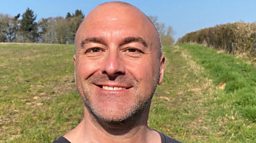Tectonics 2024 Artist Profile

Dr Marc Yeats is a British composer, abstract landscape painter and practice researcher.
His work as a painter and composer is closely linked to techniques developed over many years, with compositions influencing new approaches to painting and techniques in painting influencing musical development.
Compositionally, Marc is an internationally performed and commissioned composer with broadcasts on 成人快手 Radio 3, US, German, Slovak, Belgian and New Zealand radio.
Leading orchestras, ensembles, and soloists as far afield as New York and Tokyo have performed his works, with many of his compositions performed to considerable acclaim by the 成人快手, including I See Blue (1995) and PAGAN II (1997) with the 成人快手 Philharmonic, and most recently (2021), the unimportance of events with the 成人快手 Scottish Symphony Orchestras. Key commissions across the years have included a piano concerto with the 成人快手 Philharmonic titled the round and square art of memory (1999), a composition for the Hallé Orchestra to celebrate World Aids Day 2008 (My Blood is as Red as Yours), the a cappella choral piece sturzstrom for the 2012 Cultural Olympiad held in the UK, and Forget-Me-Not (2016), a vocal installation commissioned by Yeovil District and Dorchester County Hospitals exploring dementia, along with a great many chamber and ensemble pieces. Most recently, Marc has begun collaborating with the English Symphony Orchestra, writing solo pieces for the principal players that will culminate in a commission for the orchestra.
Published by Composers Edition and with his music represented in many international libraries and online through Pro Quest and Alexander Street Press, Marc continues to push his compositional horizons through the incorporation of mobile technologies employing user-responsive materials in geolocated contexts––compositions audiences can walk through and explore––and live performance formats through a range of polytemporal structural approaches including his timecode-supported polytemporal composition method developed as an AHRC funded PhD research project at the School of Music, University of Leeds between 2017 and 2021.
Marc has presented his research into polytemporal composition at the University of Manchester School of Music (November 2018), The University of Leeds School of Music (2018/2020), the BFE-RMA Research Students’ Conference (January 2020) and most recently, The City University of New York (April 2023).
As a researcher and writer, Marc’s forthcoming book, Music, Painting, Landscape, and Me, delves into the interplay between his roles as a composer and painter, exploring the profound connections that both share with the landscape. Vision Editions will publish the book in the Spring of 2024.
a point in the landscape (2020)
a point in the landscape is dedicated to my friend and colleague, the conductor and musician Ilan Volkov, who recognised the potential in my timecode-supported polytemporal methodology for composing and performing perceptually complex polytemporal orchestral music—a leap of faith for which I am deeply grateful.
a point in the landscape is a timecode-supported polytemporal orchestral piece. It operates without a conductor, click-tracks, or a traditional score. Instead, music is performed from fully notated individual instrumental parts, all operating at simultaneously different speeds. In this unique approach, the players are responsible for unfolding the piece. To achieve this, they utilise a timecode, represented as minutes and seconds above each bar in their parts, to indicate the duration and the passage of time. Players also use loosely synchronised individual mobile phone stopwatches displaying clock-time passing to provide coordination. The goal is to achieve a rough synchronisation between the timecode and digital clock time during the performance. The closer this synchronisation, the closer the rendition reflects my compositional model.
It’s crucial to note that this unfolding process does not yield precisely repeatable performance outcomes. The balance between my intentions conveyed through notation and the players’ interpretations using timecode and stopwatches makes the vertical alignment of its details during each performance a unique iteration. At the same time, the global architecture of the piece remains largely stable.
In this music, the audibility of polytemporal layers is secondary to the fluid, quicksilver and transformative relationships the method enables between players and their materials. Generating unique experiences for audiences, ensembles, and orchestras, each player is a soloist, performing in their independent tempi and enjoying temporal, expressive, interpretive, and spatial freedoms that are difficult to achieve within the framework of conducted music.
To avoid descending into sonic chaos and establish a dramatic impact between materials, extremes of polytemporal density within the piece are contrasted with less dense and less chaotic-sounding content. The movement between these two states—between perceptual obfuscation and clarity—occurs multiple times within the piece’s 20-minute duration. These transitions mark the cyclic journeys that constitute the work’s narrative and structure—a narrative propelled forward by an often-relentless momentum that, like a moth drawn to a flame, burns out in the composition’s final moments, returning all sounds to the silence from which they emerged.
To help distinguish the multiple polytemporal stratifications of this sonic landscape, the orchestra is divided into eight spatially positioned ensemble groups located around the performance area. Each group comprises different instrumental arrays with no exact temporal relationship to any other. The goal is for the audience to experience the music from among these groups, providing each listener with a uniquely different aural perspective.
The culmination of spatialisation, polytemporal performance and heterogeneous materials makes this a music of extremes. It is characterised by hyperactivity, hyper-density, quicksilver colouristic fluctuations and perceptually complex sound combinations articulated through virtuosic instrumental part writing. This requires great technical facility, expressive insight and emotional stamina from performers when mediating its notation and instantiating its sound. From the listener’s perspective, the music can be experienced for its physicality, energy and contingency. As for its meaningfulness, I’ll leave that to each listener to ascertain from whatever point within the musical landscape they find themselves.
